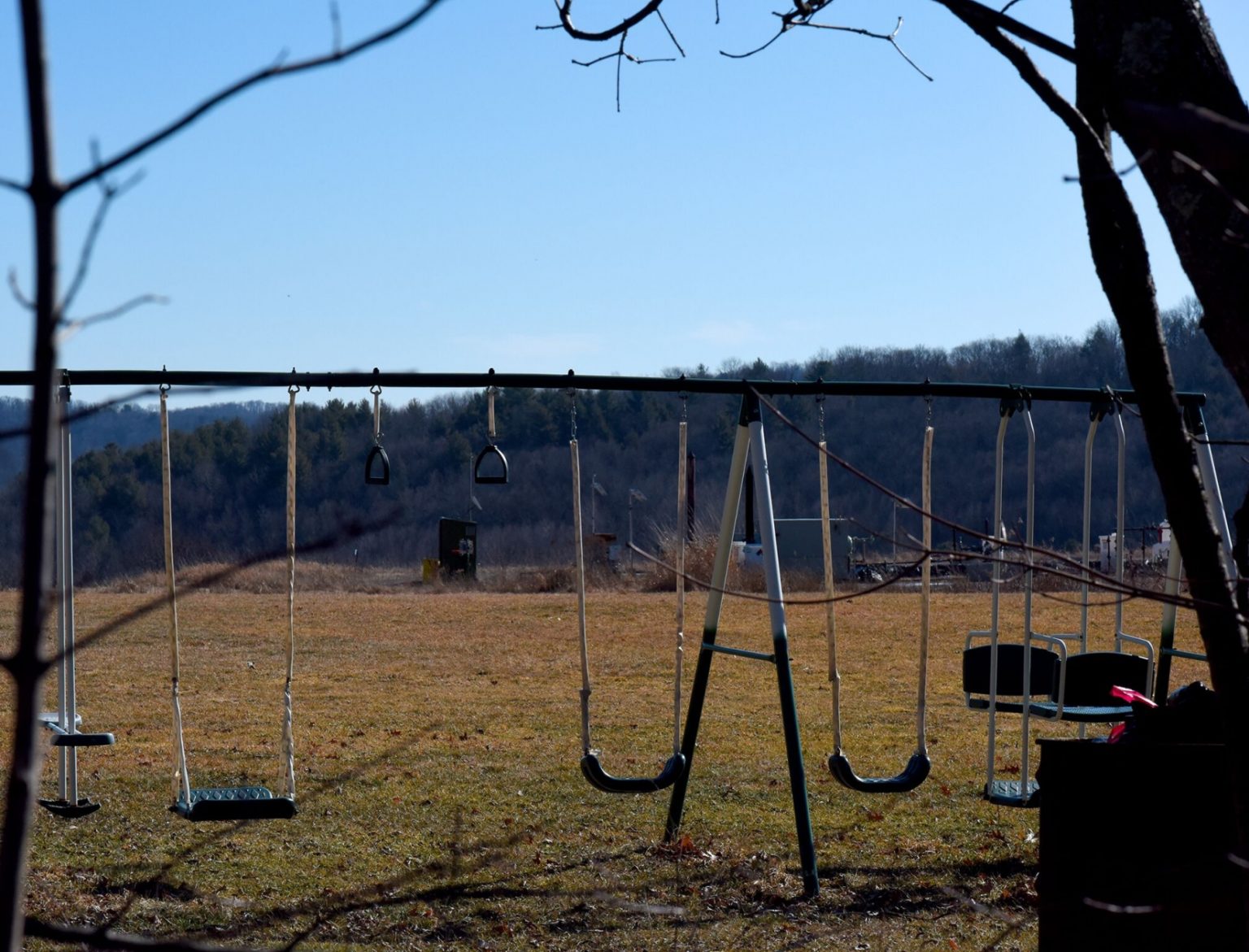A newly published peer-reviewed study concludes that air pollution from fracking puts people’s lungs, hearts, and immune systems at risk – and that the health risks are particularly pointed for young children and infants.
The study — the first to specifically focus on how shale oil and gas drilling affects children ability to breathe — concludes that starting in the womb, children’s developing respiratory systems are particularly at risk from five airborne pollutants associated with fracking and drilling.
“We conclude that exposure to ozone, [particulate matter], silica dust, benzene, and formaldehyde is linked to adverse respiratory health effects, particularly in infants and children,” the researchers wrote in the study, titled “Potential Hazards of Air Pollutant Emissions from Unconventional Oil and Natural Gas Operations on the Respiratory Health of Children and Infants” and published in Reviews on Environmental Health.
“While the rapid growth of this industry was undertaken without substantial public health research, there are now numerous publications clarifying health risks and, increasingly, health outcomes,” they wrote, adding that since 2013, over 560 peer-reviewed studies on unconventional oil and gas extraction’s impacts have been published, representing over 80 percent of the scientific literature on the topic. In other words, in the last few years, the risks from fracking have become much more heavily studied – and the results show good reason to be concerned about how people’s health is being affected.
Based on the risks associated with breathing air laced with the five most-studied pollutants, the researchers expressed concern about fracking near homes, day cares, and schools. “We recommend that at a minimum, one-mile setbacks should be established between drilling facilities and occupied dwellings such as schools, hospitals, and other dwellings where infants and children might spend a substantial amount of time,” they wrote.
But state rules generally fall far short of that buffer zone. There is no national data available on how many schools or childcare facilities are now within a mile of a fracked well, in part because there are no federal regulations requiring the industry to track that data. Each individual state sets different rules controlling how far well pads must be from schools – and those rules vary widely across the U.S.
All told, over 17 million Americans live within a mile of an active oil or gas well – but the precise number of children within the one-mile zone nationwide has never been formally tallied, and not all of those wells are the unconventional oil and gas wells that the new study specifically focused on.
In Pennsylvania, the researchers noted, over 53,000 children under 10 live or attend school within a mile of a permitted fracked well. A separate mapping project, conducted by a group called Healthy Schools Pennsylvania, discovered more than 40 pipeline compressor stations – notorious for spewing pollution into the air – within a mile of the state’s schools, and found that one school district that had over 40 oil or gas wells within a mile of its schools. In Pennsylvania alone, over 400 documented violations of state environmental laws occurred at wells located within one mile of a school or a day care, and 13 violations occurred at wells less than a mile away from a hospital.
And it’s not just an East Coast issue. In four northern Colorado counties, researchers from the Western Resource Advocates found 32 schools within just 1,000 feet of a fracked well in 2012.
“Our research shows that the current setback distances between fracked gas wells and homes, schools, and health care centers are not enough to protect public health, especially children,” Dr. Marsha Haley, an oncologist at the University of Pittsburgh Cancer Institute, told the Pittsburgh Post-Gazette after she authored a different peer-reviewed study. That study, published on Feb. 19 in the National Institute of Environmental Health Services journal, concluded that current set-back standards not only put children’s long-term health at risk from air emissions, but are also not strict enough to protect against risks from accidents and explosions.
Black and Latino parents may have particular reason to be concerned about the risks associated with oil and gas drilling and fracking, an investigative report by ThinkProgress in 2014 found.
“In California itself, 79 percent of the more than 350,000 kids who live within a mile of an oil and gas well are non-white, while 60 percent are Hispanic,” reporter Emily Atkin wrote. “Coincidentally or not, some parents of Sequoia kids [in a town where 82 percent of residents are Hispanic] have complained of their kids suffering headaches, dizziness, and nausea. More alarming complaints have popped up as well, according to Juan Flores and Madeline Pano of the Center for Race, Poverty and the Environment, who both work closely with families in Shafter: A 12-year old student experiencing epileptic attacks; a nine-year-old student diagnosed with prostate cancer; an 11-year-old student who died from a mysterious illness that four hospitals could not diagnose.”
“Community members are questioning, why are these things happening in this community?” Flores told ThinkProgress. “Why are kids getting sick?”
The new study, the most comprehensive review of the literature to date, comes on the heels of several in-depth looks at issues related to fracking and child health, including a December 2014 study linked fracking-related chemicals to infertility, low birth weights and impaired growth in the womb, as well as a litany of potential health problems after children are born.
“People really near unconventional oil and gas and fracking sites and those who work in the fracking industry have the right to know the chemicals that are being used that may pose health threats, especially to vulnerable populations like women and children,” Ellen Webb, energy program associate at the Center for Environmental Health, told U.S. News and World Report when her 2014 study was published. “Given the lack of study and understanding of all the chemicals that are being used, we can’t know the extent of the risks.”
As troubling as the new study’s results might be, they represent only the tip of the iceberg, since most of the chemicals used by the oil and gas industry for fracking remain gravely under-studied.
In part, that’s because little health testing is generally required under the Toxic Substances Control Act, the main federal law that covers chemical safety – including many chemicals used for fracking, a recent report by The Partnership for Policy Integrity found.
Out of 99 chemicals that researchers selected for review, only two had health studies available in the public docket (and in ten cases, companies claimed to have provided that information, but the health data was in fact missing or labeled confidential). Although the Environmental Protection Agency expressed concerns about potential health impacts in 88 cases, they only requested health studies for five of the chemicals – and went on to approve virtually all of the chemicals for manufacture.
“Chemical companies and the EPA are basically conducting a chemical experiment on the general public,” said Partnership for Policy Integrity Senior Counsel Dusty Horwitt.
And while there are efforts underway in Congress to revise the laws, those efforts fall far short of the mark, Mr. Horwitt said. “Chemical reform bills that have passed the House and Senate do not fix the problem.” Horwitt added. “Congress and President Obama need to fix the law to ensure that chemicals are regulated with rigorous testing and openness so that citizens can be protected and informed.”
Meanwhile, the risks specifically associated with fracking have begun to draw the attention of politicians at the national level.
“The toxic chemicals used in fracking are known to cause lung cancer and birth defects,” presidential candidate Bernie Sanders wrote in an April 18 op-ed. “If we are serious about safe and clean drinking water and clean air, if we are serious about protecting the health of our children and families, and if we are serious about combating climate change, we need to phase out fracking nationwide.”
Photo Credit: A children’s swingset with fracked gas well in the background on Carter Road, Dimock, PA, Copyright 2016 Laura Evangelisto
Subscribe to our newsletter
Stay up to date with DeSmog news and alerts







